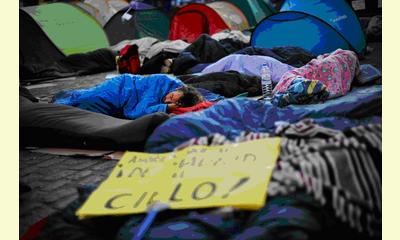|
|
An Impression of the Youth Democracy Movement in Spain
un article par Suvi
Recently I visited Madrid in Spain on holiday and witnessed demonstrations of young people in the center of the city. The demonstrators had been sleeping outside in tents in the Prado area to protest the policies of the banking industry. As I walked through the city center, I noticed that many of the ATM machines had red paint and slogans written on them. In addition, in front of the Ministry of Finance, I saw a painted slogan that said “No one represents us!” I am sure that the young people had something to do with the existence of these new paint creations. 
click on photo to enlarge
While the demonstrators were still asleep, the sanitation workers came to erase some of the paint. They seemed annoyed to have their pictures taken while cleaning the paintings.
The protesters blamed the banks and other financial institutions for economic policies that caused the economic recession. The young persons said that after the banks were bailed out with taxpayer money the government and the financial institutions did not adopt any alternative strategies to avoid a repeat of the financial chaos. The demonstrators also stated that they wanted to create a real democracy which represented their interests and not the interest of the financial institutions.
The demonstrators came from many different parts of the country, walking in some cases several hundred kilometers. They were a diverse group – some unemployed, others students, and yet others who were working. People who sympathized with the young protesters and shared their ideals also joined their ranks.
Some demonstrators stated they planned to walk to Brussels to express their views and join with other like minded individuals and groups. They seemed determined to promote change that will not adversely effect the innocent victims of what the demonstrators perceived as reckless policies of the banks and other financial institutions. http://international.democraciarealya.es.
|








|
DISCUSSION
Question(s) liée(s) à cet article:
The Arab spring of 2011, Can it inspire democratic movements around the world?
* * * * *
Commentaire le plus récent:
The following is reprinted from Common Ground News Service (CGNews), 30 August 2011, www.commongroundnews.org
Copyright permission is granted for publication.
Cultures of peace, lasting change in Egypt?
Joseph Mayton
Cairo - Instead of falling victim to Egypt’s eye-for-an-eye past, a concerted effort to create a culture of peace in what has quickly become a starkly fractured political scene – between religious groups, the military and activists, and activists and the people – may well be the best opportunity to bring about a new Egypt with social justice, transparency and tolerance.
Egyptians are striving daily to show the world that societies can change. Cairo is not the same city it was six months ago. As voices now begin to breech the political and social stalemate in the country, Egyptian society can, through a culture of peace, set a precedent not only for their own country but for the whole region.
UNESCO defines the culture of peace as “a set of values, attitudes, modes of behaviour and ways of life that reject violence and prevent conflicts by tackling their root causes to solve problems through dialogue”. In Egypt, for example, this could help develop an overall sense that the "other", who participated in violent acts in the past, can become part of society, instead of remaining on the outskirts as they are currently. Building such a culture in Egypt would follow the South African model of reconciliation, which allowed the country to look forward instead of focusing on the frustrating and sad past of apartheid.
Instilling a culture of peace in the younger generation could be a great antidote to the older generations’ mistrust and antagonism toward one another – Christian versus Muslim; Worker versus Owner; Military versus the People; and so on.
In Egypt, one of the root causes of a lack of a culture of peace is the educational system. Young Egyptian students are taught that they are different from one another, that their respective faiths are cause for separation. In schools, Christian students study the history and faith of Christianity separately, while Muslim studentsdo the same for Islam. This creates a sense that each group is separate and divided when it comes to any national cause. . ... continuation.

|
|








